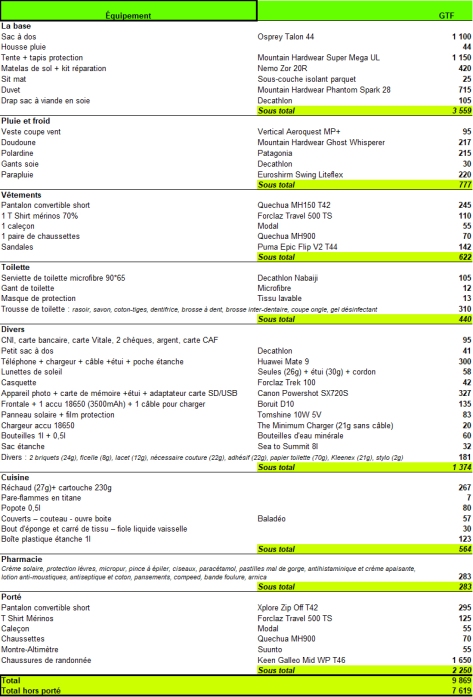The way, useful information, daily stages, GPS tracks of the hike through France, Northeast to Southwest, from the German border to the Spanish one with on the way, all the mountains of the country (Vosges, Jura, Alps, Massif Central and Pyrenees) : “La Grande Traversée de la France”, 2500 kilometers (1550Mi) and 117 kilometers of ascent (380000ft).
All the pictures of the Grande Traversée de la France :

The Grande Traversée of France
The ultimate thru hike? A very progressive way, mythical routes such as the Grande Traversée des Vosges, the Grande Traversée du Jura, the Grande Traversée des Alpes (GR5 to Mount Thabor before going west), parts of the way of Stevenson in the Massif Central and the wild HRP in the Pyrenees at the end, a very mountainous way but also typical small villages, castles, french gastronomy… still little known, the Grande Traversée de la France can become a must with various initiatives that are being implemented. Hurry to be one of the pioneers.
My way:
See the details of the stages, GPS tracks, as well as all the information on logistics (resupply, accommodation, water …) in the following pages :
Lexicon :
Bivouac: wild camping, usually according to French regulation, in a small tent (where you can’t standing) and pitched only for the night.
Abri: shelter. It’s unclosed (no door, some with just a roof) quite similar to those on the Appalachian Trail.
Cabane: small hut or shelter. It has a door. Some “cabanes” are occupied in summer by shepherds and open the rest of the year.
Refuge non gardé : unattended hut. Unlike a simple “cabane”, usually there are beds with mats.
Refuge: hut. You sleep in dorms, they can provide meals. Some of them even have showers.
Gîte d’étape: It’s like a refuge (or hostel) but accessible by road. You sleep in dorms (some have also bedrooms), they can provide meals. You will find “gîtes d’étape” on the main hiking trails (for example in Massif Central)
Internet websites:
A fairly similar way, the Hexatrek was created in 2022. The website provides tracks, logistics, point of interest and an application. The way is 500 kilometers longer than the one I hiked. This is particularly the case in the Alps where my track is much more direct. On the other hand, the Jura massif is cut off halfway without going to the Crêt de la Neige to reach the Alps by crossing Lake Geneva by boat.
In addition to the websites mentioned on the pages for each massif, the site gites-refuges.com is useful for information on huts and “gîtes d’étape” and that Refuges.info for huts and shelters.
See the site LeCampingsauvage.fr for regulations in France for bivouacs or wilderness camping.
My backpack
Since the Appalachian Trail in 2017, then the Balkans in 2018 and Eastern Europe in 2019, I have almost the same equipment with a few small modifications each year. I’m OK with it, it gaves me satisfaction. I needed everything and lacked of nothing. The major development of 2020 is to go below 8kg carried excluding water and food (exactly 7,62kg/16,8lbs) . I replaced my “city” down jacket with a model more suitable to sports and more efficient (Mountain Hardwear Ghost Whisperer). I also replaced my worn windbreaker jacket (more than 10 years old, a little torn and sewn, no more waterproof) with a recent model : Vertical Aeroquest MP +. It is a big weight gain (150g compared to the previous model). It seems very fragile to me but I used it olny once (best to avoid dense vegetation, brambles, rocks …).
I had a special new item in 2020 : a mask. On the other hand, I don’t plan to hang my food. I’m not afraid of the bears in Pyrenees : we are cousins…
I could have gone a little close to 7kg by changing the heavy elements (backpack, tent, down, mattress) by new products, today on the market and lighter. I kept my tent. I’m happy with it. It is it fifth year. Quite large (supposed to be for two), it allows you to be comfortable when you are inside, with the backpack, with bad weather. There are now lighter mats, but that would be an investment to gain barely a few grams. For the backpack, North Face with its Hydra 38l around a kilo or Salomon with its Out Week 38 + 6l announced for 815g should be tested.
Without being a purist of ultra light hiking, less than 8kg without water and food seems very reasonable to me to be independent and able to remain comfortable in slightly negative temperatures.
Phone charge: I will sometimes hike several days without being able to charge it. Until now, I had my phone (4100mAh battery) + two 18650 batteries given for 3500 mAh (one of which is also used for the headlamp). This allowed me to have about 6 days of autonomy with a very controlled use of the phone. I bought this year a Tomshine 10W 5V (85g) solar panel and only carried one 18650 battery from the headlamp. The overweight compared to last year is only 35 grams.

